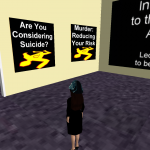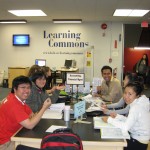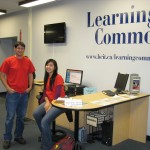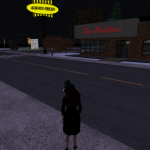by Deirdre ~ November 27th, 2009
After reading about my classmates experience in SL I felt a little nostalgic and decided to head back in. It’s funny, logging in after a long time and Althea, my avatar, is just waiting for me where I left her, although there was a new basket of fruit on the table which made me wonder who else had been around….
Since I visited a lot of libraries and educational sites during my experience last year, I decided I wanted to try somewhere new. For some reason I decided on forensics and ended up in the Medical Examiner’s Office – Forensic Pathology. It was not immediately apparent who created the site, but there was a lot to look at, and lots of free stuff (always a bonus…)

Signs, signs, everywhere a sign...
They used to call the internet the information highway, or something like that, but it’s Second Life that’s scattered with billboards everywhere – it’s strange with such a powerful technology the best way to communicate is BIG SIGNS and LOTS OF THEM…
As I said, there was lots of free stuff – Tshirts, autopsy gloves and aprons in different colors, various wounds you could put on. I took it all. It was all free. However, when I put on my apron, my skirt came off! I don’t know a lot about forensics, but I don’t think this is standard procedure at all. Luckily, there was no one else there. Which is also typical of what I remember about Second Life – unless I made previous arrangements, I was always flying solo.
Even Tim Horton’s was deserted… and you know this never happens in real life, no matter what time of day.
So, it sounds like I’m making fun of Second Life. And I am. Because it’s goofy.
But I do think it’s early days, and even at this stage there is value in immersive worlds. There is no denying they are extremely engaging. Just visiting the medical examiner’s office, Tim Horton’s, an art gallery and a monastery I was gone for over an hour and it seemed like minutes. Bringing that engagement to learning will be valuable. Information professionals have a ‘role to play’ (pardon the pun) – knowing how to navigate these worlds and find the resources within them.
Filed under: Uncategorized | 2 Comments »
by Deirdre ~ November 14th, 2009
Back in September Nathan posed the question on his blog – Is Second Life Getting Any Better? I confess, after doing a professional experience project last year on the possibilities for a Resource Rooom on BCIT Island, I have only visited the virtual world a handful of times – but because I did some presentations on it at BCIT and my avatar was featured in a staff newsletter, I often get questions about it. The queries are often about how to get a good outfit. It seems there is so much potential for virtual worlds, but people end up spending a lot of time making sure their avatar is well-dressed. And many educational organizations, including universities and libraries, give away virtual T-shirts and hats. Why is how our avatar looks so important?
A great explanation is listed on page 7 of the Alliance Library Systems Report [pdf] on their first year of operation in Second Life. Kitty Pope calls it the Sousa effect – “The marching band enthusiast John Phillip Sousa achieved tremendous success organizing bands, not only because people have an innate desire to play a musical instrument and belong to an organized structured group but also because they get to have new band uniforms.”
This all came to mind this week because I came across What not to wear in virtual circles in the Tiimes Higher Education. It seemed humourous that avatar fashion was newsworthy in an academic pubication, but I found the solution proposed by one commentator very interesting: “My solution is to have two avatars: a boring one for institutional business, and one with a more adventurous character- and a much more extensive wardrobe-that I use for recreation.” It brought back the discussions around online identities, performance and the blurring of work and personal identities in the early weeks of this course. As for myself, my avatar Althea Snoodle wears a BCIT T-shirt and keeps it professional (see left sidebar).
Filed under: Uncategorized | 3 Comments »
by Deirdre ~ November 6th, 2009
Yesterday I had the privilege of attending a webinar Informal Learning Spaces on Campus presented by David Zaiser. It was especially interesting because I had just recently watched Dr. M. Wesch’s inspiring podcast The Future of Education. What the two presentations have in common is a focus on student-centred learning and the strong role collaboration has to play in learning.
I have a keen interest in Learning Commons, mostly because I work at the BCIT Learning Commons. The dual rise of Web 2.0 and the Commons phenomena always intrigued me. It is only this term, due to a Directed Study on Learning Commons and Libr 559M that I have realized collaboration and digital information are the common factors between the two. The Learning Commons is all about providing spaces and services that enable collaborative learning and that allow students to access and manipulate digital information. Social media is all about collaborating to create and share digital information.
Now that this epiphany has occurred it just seems to be hammered home again and again – as in the two presentations this week.
And to close I will show you some pictures of our lovely BCIT Learning Commons…




Filed under: Uncategorized | 2 Comments »
by Deirdre ~ October 29th, 2009
Filed under: Uncategorized | 2 Comments »
by Deirdre ~ October 22nd, 2009
Educause‘s applied research branch ECAR just released their 2009 Study of Undergraduate Students and Information Technology. This is a survey of over 30,000 undergraduates at over 100 institutions. The study has been done annually since 2004 so longitudinal comparisons are possible. Scanning the Key Findings and Road Map, I found the following information most interesting:
– 94.6% use the library website, with a median frequency of use weekly – to me this means that even with the tremendous amount of competition available from other information providers, the library is still relevant for students
– 2/3 disagree or strongly disagree with the statement, “I can skip classes when course materials are available online” – this relates to a discussion going on in 559 about whether students would bother attending clases if podcasts or iTunes of lectures were available
– there is a preference for a hybrid model – a moderate amount of technology in courses, but face-to-face instruction is still desired and,
– in answer to open ened questions some students wrote explicitly about a preference for “real books and people”
Technology offers us all sorts of possibilities and can’t be ignored, but we shouldn’t forget the human touch.
Filed under: Uncategorized | 1 Comment »
by Deirdre ~ October 15th, 2009

The idea of Blog Action Day is to get as many bloggers focussed on one topic at the same time to generate excitement and publicity. This year’s topic is climate change. Using social media for positive change is so appealing. The ability of the medium to generate buzz and foster conversation shouldn’t be underestimated.
I had never heard of Blog Action Day until today. Yesterday I decided to test out Metcalfe’s Law and almost doubled the amount of people and organizations I was following on Twitter. As a result I am receiving much more information, most of it quite useful. I have also acquired new followers so my own tweets will be sent out to a larger audience.
This morning I received a tweet about Blog Action Day and was intrigued enough to follow up. Over 9,000 blogs from all over the world are registered to participate and some great videos are posted on the main site. I have commemorated the day myself by posting some titles about climate change and about blogging from my institution’s library on our internal electronic announcement system. And I’m writing this post. Are you going to participate?
Filed under: Uncategorized | 1 Comment »
by Deirdre ~ October 9th, 2009
I have to stop this, but I can’t help thinking…
- If your professional and personal identity are that different, which one is the real you?
- What’s to stop you from impersonating yourself online?
Filed under: Uncategorized | 2 Comments »
by Deirdre ~ October 8th, 2009
It’s so nice when you’re taking two courses and the topics your concentrating on happen to overlap. Collaboration is so relevant to libraries it was bound to happen.
My other course is a Directed Studies on The Learning Commons in the Academic Library. Learning Commons are great examples of how an academic library can collaborate. A Commons is most often located in the library and can include some non-traditional library resources and services such as production hardware and software (Photoshop, iMovie, etc) for project creation, collaborative study space, peer tutoring, seminars and writing centres. A well planned Commons will be customized to the institution’s students and services will be tailored to meet their needs. Every Commons will be a bit different. However it is almost guaranteed that every Commons will require the library to partner with other departments – like IT services, academic departments, student employment services to name a few – in order to deliver optimum services.
However this partnering or collaboration is new to many libraries (and probably many other campus departments) who are used to operating in their own silos. For librarians in particular, the collaborative effort of a Learning Commons signals the loss of the traditional library and perhaps even their professional identity. An article by Susan Beatty (2008) cites Donald Robert Beagle (2006) as desribing the Learning Commons “as transformative change for the library, where the commons is organized in collaboration with learning initiatives sponsored by other academic units and, in effect, the library disappears.” If you’re not ready for change, this can be a scary thought…
Filed under: Uncategorized | No Comments »
by Deirdre ~ October 2nd, 2009
On professional versus personal identities online….
- Is who we are professionally that different than who we are in our personal life?
- Do we need to maintain separate identities with strict boundaries for each?
- Did the separation of personal and professional arise as a result of industrialization? Did we become fractured people when we started maintaining a separate work life and home life?
- Will social networking bring us full circle and mesh our separate identities into one?
- Am I losing my mind?
Filed under: Uncategorized | 3 Comments »
by Deirdre ~ October 2nd, 2009
The phrase in the Albrechtslund article I found most intriguing was “construction of identity.” You can represent yourself as a close approximation of who you really are, or you can be who you always wanted to be. This does afford you some power, at the cost of privacy.
It also allows you to manage your reputation. In The Perils of Sharing, Andreas Kluth acknowledges how quickly you can lose control of your online reputation but maintains it is important to have an online presence in order “to inject your own perspective.” He also advocates for a new etiquette which will make people more sensitive to sharing information about others.
And the fact is, if you don’t construct your identity, someone may just assume it as their own, as happened to chef Michael Smith this week.
Filed under: Uncategorized | 1 Comment »






